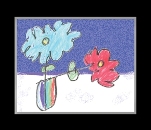Paper batik is based on a method used for dyeing textiles in Indonesia. A pattern is drawn on paper using wax and then the paper is dipped into inks, dyes or watercolors. The wax prevents the color from penetrating the design areas.
Lesson Plan Suggestion: The history of batik is an excellent opportunity to discuss how ideas and art technique spread from one country to another. Thought to have originated in Indonesia on the island of Java, batik spread to other countries through international trading routes. Countries like Africa and China developed their own batik methods influenced by the natural materials available and the cultural background of its artisans. Batik is also easy to incorporate into lesson plans about wildlife, insects and other natural elements.
- Start with a light colored paper. Papers with cotton fibers often give the best results.
- Cover your work area with a thick layer of newspaper.
- Draw a design on your paper using an unlit candle, a crayon or paraffin wax. These different wax sources all provide a different effect in creating paper batik.
- When you have completed the design, gently crumple the paper into a ball.
- Smooth out the paper and then dip it into a shallow pan filled with a light colored ink or water color paint. Wait for the paper to completely absorb the color.
- Allow the paper to dry thoroughly.
- If desired, add wax patterns over the inked areas. Dip the paper into the ink again, this time using a darker shade.
- Allow the paper to dry.
- Remove the wax by scraping it off with a credit card or by ironing the paper between sheets of newspaper.
- You can obtain multicolored and blended effects by scraping of the initial wax pattern and repeating the dying process several times.
